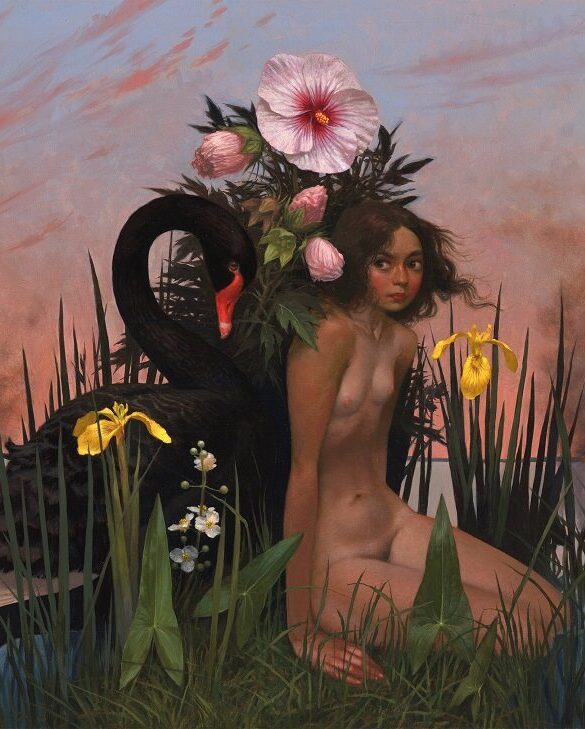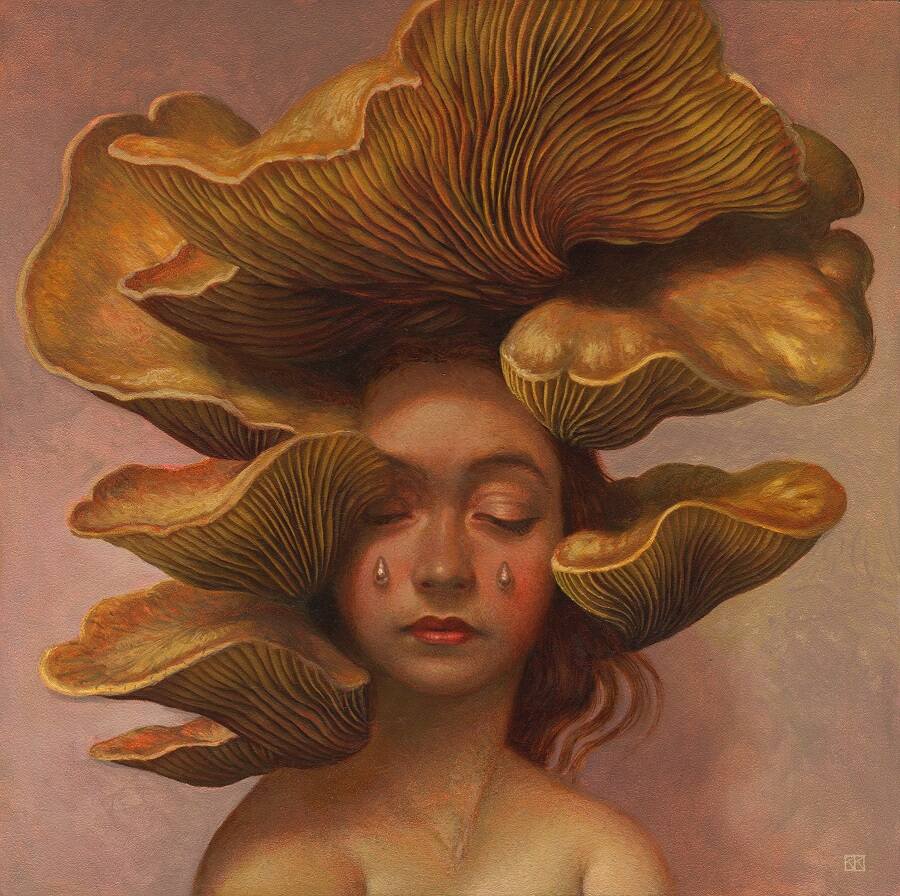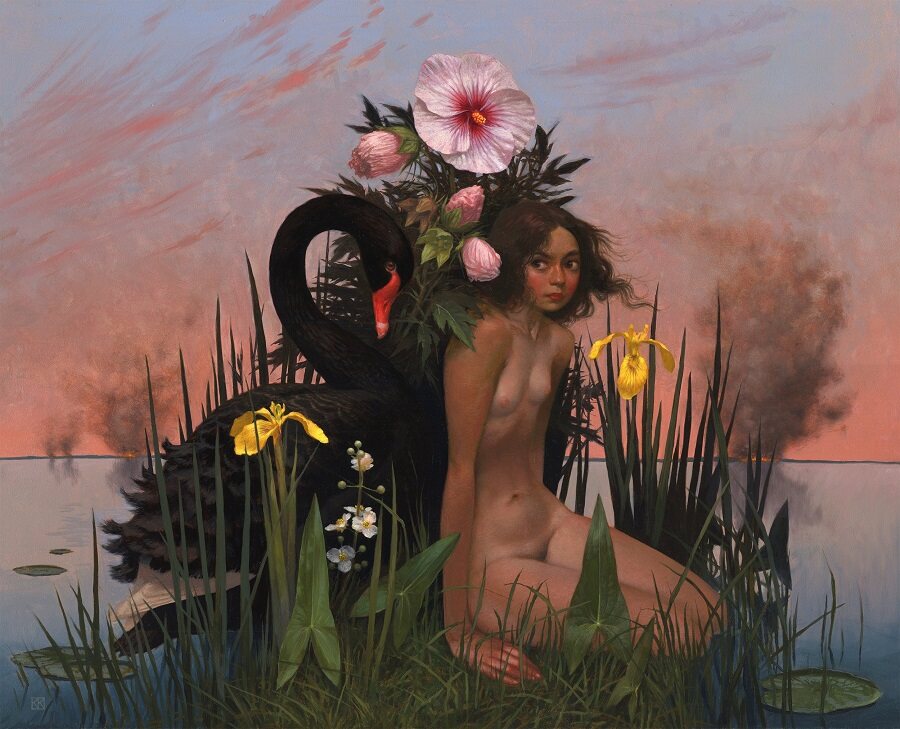Exclusive Interview with Kristin Kwan, Grand Prize Winner of the 2022 Beautiful Bizarre Art Prize conducted by Richard Purssey
In these troubled times of pandemic, wars, climate change-induced disasters and runaway inflation, we all need something to lift our spirits and lighten our hearts. Let me introduce you then, to the perfect panacea for what is occurring in the world today, the uplifting and joyful works of the Grand Prize winner of the 2022 Beautiful Bizarre Art Prize, painter Kristin Kwan of Lincoln, Nebraska, USA.
Although suffering her own personal travails – in addition to the seemingly endless dumpster fire we are served up in the nightly news bulletins – Kristin has managed to bring us all to a happier place. A place where we can just be in the moment, appreciating the beauty of her quirky oil on panel artworks, reading our own story into the surrealism and symbolism therein, and emerge feeling that although the darkness can sometimes feel overwhelming, there is still light, beauty, and delight to be found. Reducing the tempest that surrounds us, if even just for a while, into a storm in a teacup – or a bathtub!
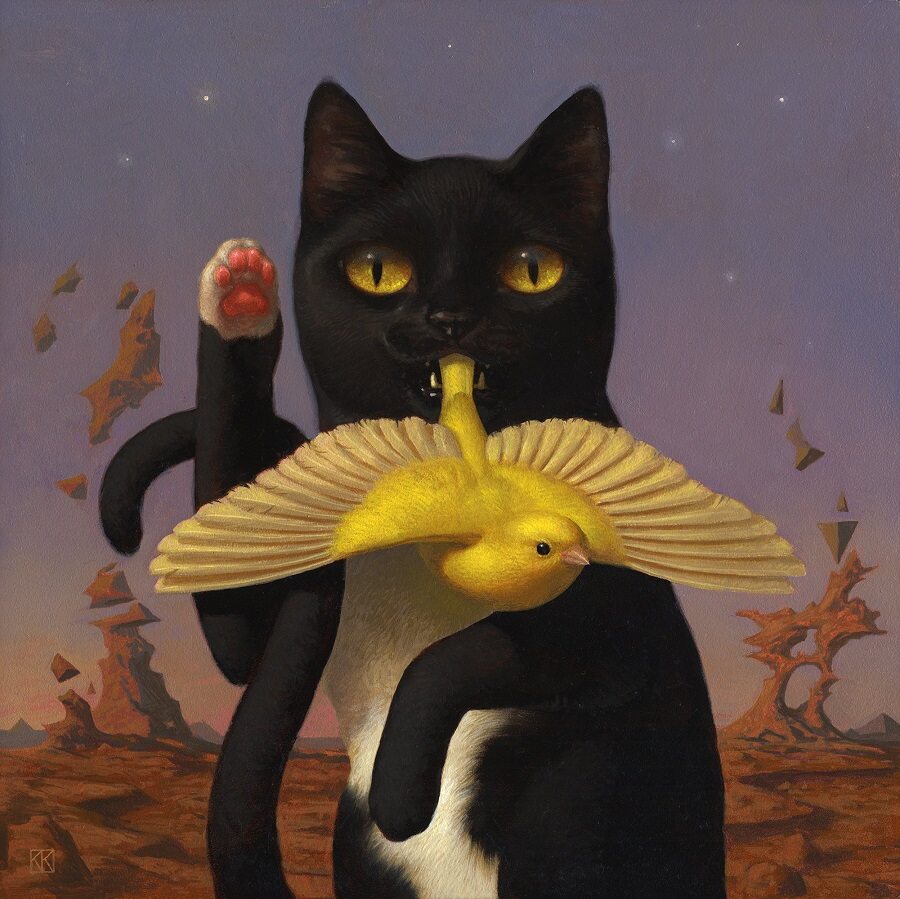

Although only exhibiting since 2019 (can we even count the ‘lost years’ of 2020-21?) Kristin has rapidly gained a devoted following online, participated in many group shows, and held her first solo shows – with many more to come. Although her skill and technique with oils is clearly evident, it is the themes of her work, an elegant mix of fable, fairy tale, and the beauty of nature – with a healthy dash of Lewis Carroll added for good measure – that makes her work irresistible to the viewer. Kristin’s art takes us away from where we are to a place where we would far rather be.
Yes, art can be powerful, can make arresting and important statements on the world as it is and how we must struggle to make it as it should be. But, equally, art can bring us respite, allow us to breathe and experience that sometimes most elusive of emotions – joy.
My goal is to keep moving towards fearlessness.
Exclusive Interview with Kristin Kwan
Congratulations on being selected as the Grand Prize Winner of the 2022 Beautiful Bizarre Art Prize Kristin! There is no doubt that 2022 has seen the strongest field ever in our art prize, with more amazing entries than ever before from emerging, mid-career, and internationally renowned artists. How did you feel when you learned that you had won, and what do you hope that your win means for your practice?
Thank you so much! I have to say when I found out I had won I was just floored, absolutely speechless. I may have had a little cry. Starting out as an artist can be a real financial puzzle. It’s next to impossible to have the time and resources without some kind of outside help, and this coming now means yes, keep going, I can keep building my career as I’d hoped and dreamed.
Please tell us about the work you submitted to the art prize, “The Golden Afternoon”. What were your thoughts and inspiration while creating this painting, and why you selected this work in particular for your entry?
I liked the idea of this ludicrously large sun behind someone, a bit flat like a Byzantine icon, but painted somewhat realistically. As with most of the things I make, the initial image doesn’t have any kind of “narrative” meaning to begin with. I think I really liked the idea of painting a giant sun more than anything! But as I paint, I live alongside the painting for months, sometimes years, and a meaning always seems to grow, I think normally a private web of meanings more than a story, per se.
This painting, and the other paintings, I was making at the time were fed with the pain and anxiety of my personal life crumbling, my marriage ending and everything that felt solid and dependable felt like it had vanished, I felt very at sea. And yet through this kind of haze of pain there is still this hum of joy in the world, harder to access sometimes, but there nonetheless just throbbing away underneath it all, inextinguishable.
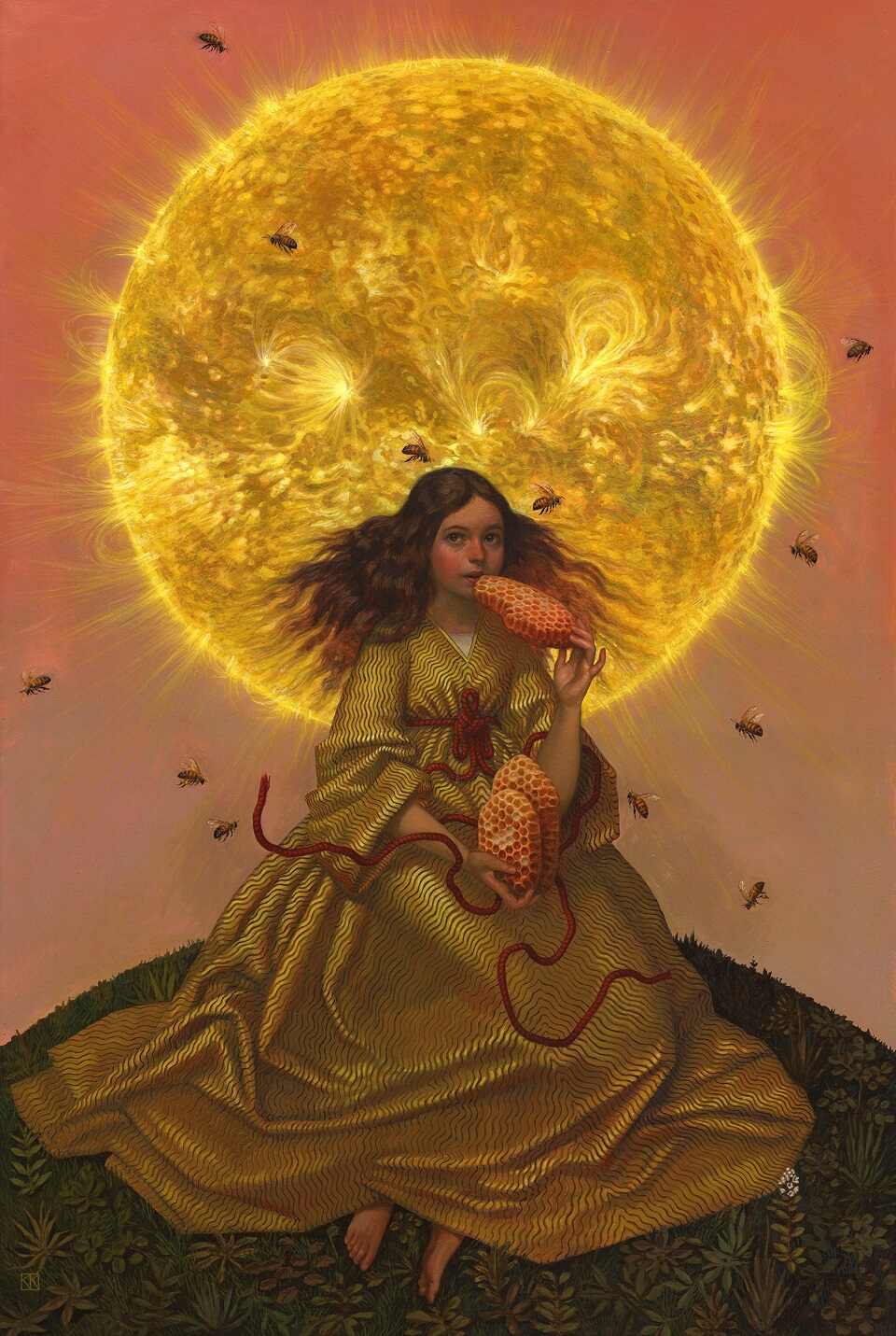
“The Golden Afternoon”
Medium & Dimensions:
Oil on panel, 36″ x 24″
It’s easy to get stuck in your head with all the fears of failure and vulnerability that come with creating art.
And the process for creating the golden afternoon, from conception to finished work?
I’d made a thumbnail sketch a year or so ago with the idea of painting a figure beneath a giant sun. I’d originally had the figure laying down, but I had another thumbnail of a girl eating a honeycomb with bees flying around her which I wanted to paint, and they seemed to work well as a single piece, so I combined them. I fiddled around with a couple of thumbnail sketches until I got one that felt right, usually something seems to just settle into place and you think, “Hmm, that feels good.”
Then I made a more finished sketch to work out the details. I like working this way, because I feel like when I paint I’m already having to make so many on the fly decisions about colour and paint consistency, technical stuff. I don’t feel like thinking about the image itself, so I plan that beforehand. Then I blow up my finished sketch to the size of my panel, print it out, and transfer it with graphite paper.
I listened to and watched quite a few things while painting this piece, since it ate up a chunk of time being so large. It’s funny, the things I watch while painting get tangled into the picture for me, so that every time I look at the finished painting after, the other thing will come into my mind unbidden. This piece makes me hear the Succession theme, Age of Adz in the weeds, Terence McKenna’s voice in the honeycomb, and a few other odds and ends that I realise only have meaning for me, but are brought back with strange clarity when I look at it.
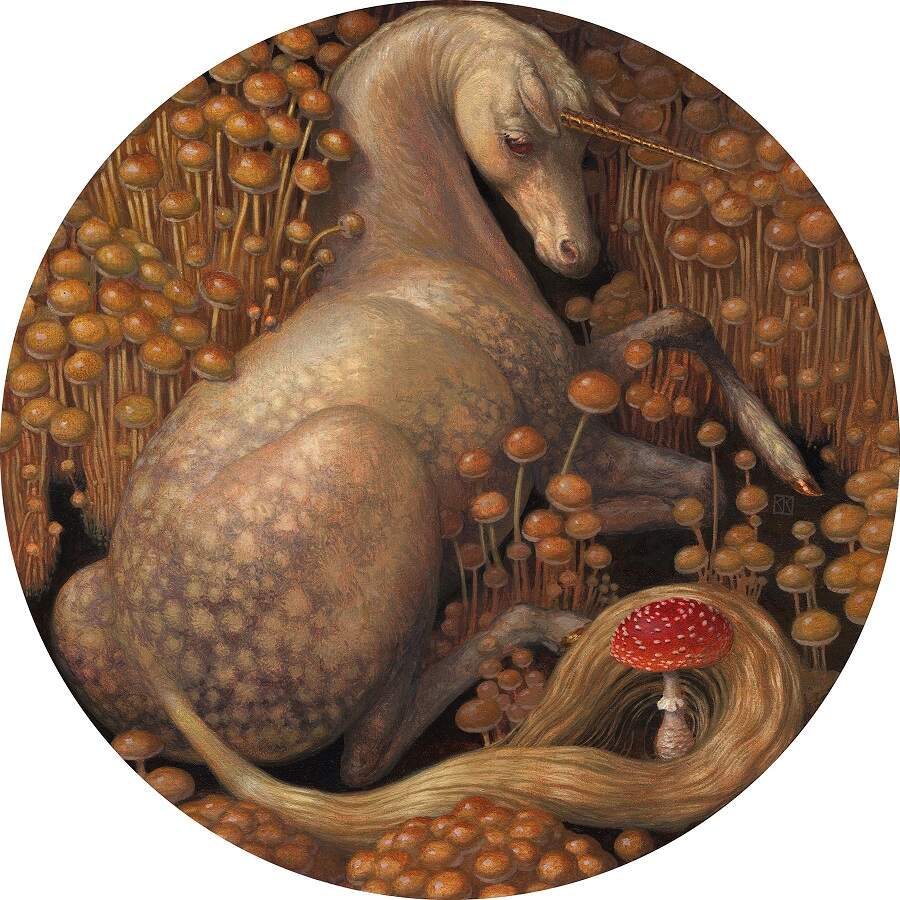
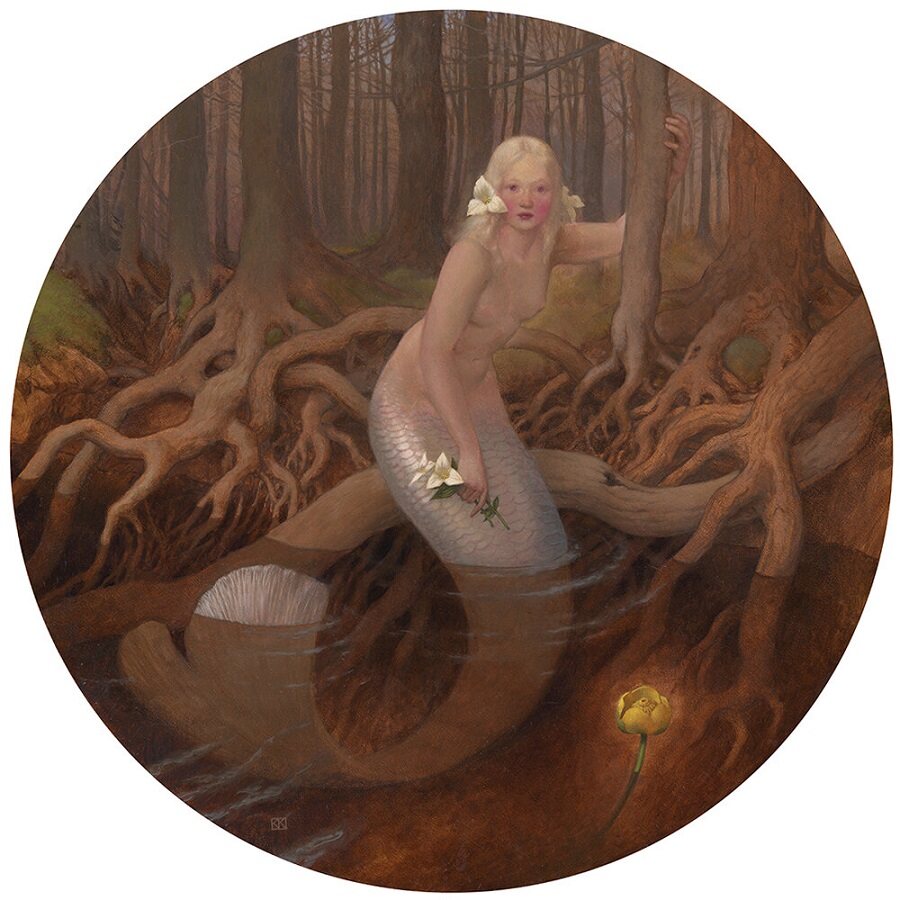
Could you tell us more about your background as an artist, how your upbringing and family influenced you?
I grew up drawing from the time I was a toddler. My parents were always incredibly encouraging of my dream to become a professional artist. My family moved around a lot, I was home-schooled and allowed to work very independently, so I’d say I had a fairly unconventional upbringing. I spent many days finishing school early, then taking off to wander in the woods or the desert or a field behind our house.
It was wonderful but I also think it may have ruined me for a normal career. I am pitiful with schedules. We also went to the library a lot. It was always one of the first things we had to do when we moved to a new town, get our library cards, that’s how you know you’re home. I’d always check out whatever art books they had. There was a library that had a collection of books of the work of Robert Bateman, a Canadian wildlife artist. I remember reading how he loved the work of Andrew Wyeth, that underneath the subject matter of the painting the abstract bones of it would exist first, and have to be something beautiful independently. I thought it was interesting, how his subject matter was almost like a secondary medium to the paint itself, something to use as well. Instead of just painting a bird, he was making a piece of art, using the bird as a shape, a colour, a line. It stuck with me.
Did you have any formal education in the arts? If so, how do you think that helped you become the artist you are today, and how have you continued to develop your skills and techniques since?
I went to Union College in Nebraska and got a bachelor’s degree in studio art. It’s a liberal arts college, not an art school, so I had the good fortune to be required to take a wide variety of classes. I also had the luck to have a student job that required very little other than sitting at a desk and once in a while answering a phone.
I read a lot of books during that time, I always had a stack from the library, anything that caught my eye, often popular science books about physics or biology or math even. I think the best thing an artist can do is have a voracious and omnivorous mind, and feed it constantly.
When you graduate with a degree in studio art your career path can be a little murky, and it took many years to find my way to what I am currently doing. Over the last few years I’ve been trying to develop my work habit skills, and I think if you’re going to make an investment of mental energy that’s the place to do it. The one thing that has made the biggest difference for me to develop artistically is just to make more work, but I was really struggling to get more than a few paintings completed a year.
When I switched my goal from getting work done on a painting, to just starting to work with no outcome in mind, that’s when things seemed to shift for me. I’m a big believer in quantity over quality. If you want to develop a style or technique, just do it a LOT. And that’s really hard with art because it’s easy to get stuck in your head with all the fears of failure and vulnerability that come with creating art. So now my goal is, start, no need to do anything but start, but you have to start 10 times every day. Then you get really good at starting, which is by far the hardest part.
Was there a particular point in your life that you realised that a career as an artist was your dream, and that you could actually make that dream come true?
It was a dream from adolescence on, with varying degrees of optimism that it could work. I remember when I was starting college and everyone asking what I was going to be studying. I replied “art”. There were a lot of skeptical looks, but my parents never doubted it was something I could do so I felt (maybe a little blindly) confident.
But after college there were a lot of times I doubted my path even though it was the only thing I could really ever see doing. Sometime around 2007 or 2008, I’d gotten a hold of a couple issues of Juxtapoz, and began using the internet as well, so I started seeing this kind of art that made me feel really excited.
I’d started painting more for myself (I’d been doing illustration work) and it was around 2011 when I began to feel like this was something I had the ideas and drive to do full time. I had my daughter shortly after and art became a bit of a hobby for awhile, but I came back to it more intensively once she started kindergarten in 2016.
While your works have stylistically classical influences, you also personalise them by applying surrealistic themes and extensive use of symbolism. What do you hope to convey with the symbolism present in your works?
The symbolism I use tends to be very personal and open ended. I shy away from using my paintings as direct narratives or vehicles for a message. They are more like collections of personal feelings presented visually. I find it extremely satisfying when people are able to overlay their own stories and meanings on a piece. Even for me, the image usually starts out almost devoid of “meaning” other than the shapes and colours themselves. As I work on it meanings start to grow in my mind, but they come after the image is set.
I like to think of a painting as some kind of communal scaffold or trellis that meaning can grow on, my own alongside viewers, and hopefully the image is enticing enough to pull a viewer in and coax them to feel their own meaning into and out of the image. That’s part of why I really love traditional western painting subjects, often from myths.
I think the fact they’ve been used over and over by so many different artists gives them a lot of layered references that are able to be pulled on if you know the story and the work. Or they can just be a visually interesting starting point for a piece, devoid of any backstory.

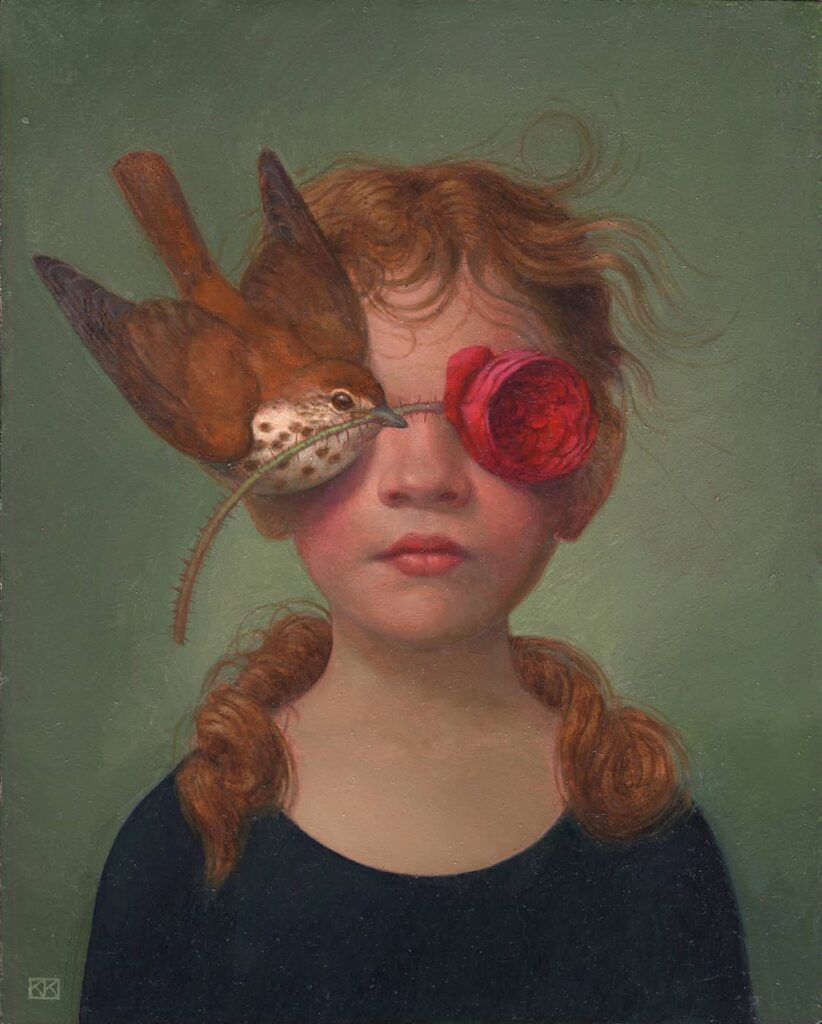
You are relatively early in your career as an artist, only showing since 2019. How has your art evolved in that time, and how do you see it continuing to evolve?
That’s right, I participated in Suggestivism at Nucleus Portland, curated by Nathan Spoor,
in 2019, my first group show. With painting more and more over the last few years, I feel like my technical ability slowly continues to develop so that I’m better able to make what
I have in mind going into a new piece. There’s often something that I will feel intimidated to paint, knowing I don’t quite have the skill to pull it off how I’d like to. There is always a bit of a dance between making something you know you can, and pushing beyond your skill level and failing and possibly scrapping a piece.
It feels a bit like with each new painting I learn a new little trick to keep up my sleeve. I’d like to be able to work faster because I have so many ideas for paintings, and I don’t know how I’m going to ever get them all painted – ha! My goal is to keep moving towards fearlessness in what I make, that I’m not ever censoring myself, or making something to show off or pander. I think good art comes from following your gut, even if it feels a bit over the top, or corny, or odd.
And to the future! Do you have any longer term artistic dreams that you wish to pursue?
My plan all along has been to paint some thing that makes me feel really excited to be painting it. That’s my long term for now, haha. I’m always convinced that the next painting will be the best one, and I suppose that positive delusion keeps things joyful.
